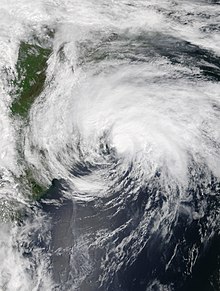 Arthur off the east coast of North Carolina near peak intensity on May 18 | |
| Meteorological history | |
|---|---|
| Formed | May 16, 2020 |
| Extratropical | May 19,2020 |
| Dissipated | May 21, 2020 |
| Tropical storm | |
| 1-minute sustained (SSHWS/NWS) | |
| Highest winds | 60 mph (95 km/h) |
| Lowest pressure | 990 mbar (hPa);29.23 inHg |
| Overall effects | |
| Fatalities | None |
| Damage | $112,000 (2020 USD) |
| Areas affected | Cuba,South Florida,The Bahamas,North Carolina,Mid-Atlantic United States,Bermuda |
Part of the 2020 Atlantic hurricane season | |
Tropical Storm Arthur was a strong off-season tropical cyclone that impacted the East Coast of the United States in May 2020. The first of thirty-one depressions and thirty named storms of the extremely active 2020 Atlantic hurricane season,Arthur marked the record sixth consecutive year in the Atlantic basin with a tropical cyclone forming before June. It was one of two off-season storms in the season,alongside short-lived Tropical Storm Bertha. Arthur originated from a front that stalled over the Straits of Florida on May 10,which slowly drifted south for two days. The system became a tropical depression on May 16 north of The Bahamas. A day later,the system intensified into a tropical storm and was named Arthur. Arthur gradually intensified while tracking towards the Outer Banks of North Carolina,attaining its peak intensity with maximum 1-minute sustained winds of 60 mph (97 km/h) and a minimum central pressure of 990 mbar (29 inHg) on May 19,before skirting the region and becoming an extratropical cyclone. The cyclone then accelerated towards Bermuda and dissipated on May 21.
Contents
- Meteorological history
- Preparations and impact
- Caribbean and Bermuda
- United States
- See also
- References
- External links
Arthur caused choppy seas and rip currents to much of the East Coast. In its formative stages,the storm brought severe weather,including hail and high winds,to southern Florida. In the state,heavy rain caused the ceiling of a house to collapse on a boy,injuring him. Tropical cyclone warnings and watches were issued for North Carolina,where Arthur brought heavy rain and tropical storm-force wind gusts to the coastline. Elsewhere,the storm caused gusty winds. No fatalities were reported from the storm,and according to the National Centers for Environmental Information,damage totaled $112,000 (2020 USD).



